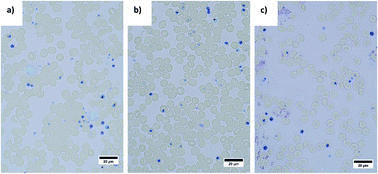Brightfield and fluorescence in-channel staining of thin blood smears generated in a pumpless microfluidic†
Abstract
Effective staining of peripheral blood smears by increasing contrast of intracellular components and biomarkers is essential for the accurate characterization, diagnosis, and monitoring of various diseases such as malaria. To assess the potential for automation of stained whole human blood smears at the point-of-care (POC), brightfield and fluorescence staining protocols were adapted for smears generated in channels of pumpless microchannels and compared to a standard glass smear. A 3× concentration Giemsa brightfield staining solutions (10, 33, and 50% dilution), and Acridine Orange fluorescence staining solutions (12 μg mL−1) were evaluated with human blood smears containing malaria parasites within a microfluidic channel. Giemsa staining at 33% dilution showed an optimal combination of contrast and preservation of cellular morphology, while 50% dilutions showed significant cellular crenation and 10% dilutions did not show desired contrast in brightfield imaging. Fluorescence staining at 12 μg mL−1 using Acridine Orange showed clear separability between the fluorescent intensities of the malaria parasites and that of the red blood cells (RBCs) and background. However, compared to glass smears, these exhibited reduced signal intensity as well as inverted contrast of RBCs and background. These results demonstrate that peripheral thin blood smears generated in pumpless microfluidic can be successfully stained in-channel with a simple, one-step procedure to permit brightfield and fluorescence imaging.



 Please wait while we load your content...
Please wait while we load your content...
